-
Paper Information
- Next Paper
- Previous Paper
- Paper Submission
-
Journal Information
- About This Journal
- Editorial Board
- Current Issue
- Archive
- Author Guidelines
- Contact Us
American Journal of Medicine and Medical Sciences
p-ISSN: 2165-901X e-ISSN: 2165-9036
2022; 12(12): 1277-1291
doi:10.5923/j.ajmms.20221212.23
Received: Nov. 11, 2022; Accepted: Dec. 14, 2022; Published: Dec. 23, 2022

Issues and Challenges in Medical Jurisprudence Due to Misuse of Wireless Sensor Technology
Md Rahimullah Miah1, Md Mehedi Hasan2, Jorin Tasnim Parisha3, Alexander Kiew Sayok4, Mohammad Shamsul Alam5, Shahriar Hussain Chowdhury6
1Department of IT in Health, North East Medical College and Hospital, Affiliated with Sylhet Medical University, Sylhet, Bangladesh
2Department of Law, Green University of Bangladesh, Dhaka, Bangladesh
3Sunamganj Government, Satis Chandra, Girls’ High School, Sunamganj Sadar, Sunamganj, Bangladesh
4IBEC, Universiti Malaysia Sarawak (UNIMAS), Sarawak, Malaysia
5Department of Forensic Medicine, North East Medical College and Hospital, Affiliated with Sylhet Medical University, Sylhet, Bangladesh
6Department of Dermatology & Venereology, North East Medical College and Hospital (NEMCH), Affiliated with Sylhet Medical University, Sylhet, Bangladesh
Correspondence to: Md Rahimullah Miah, Department of IT in Health, North East Medical College and Hospital, Affiliated with Sylhet Medical University, Sylhet, Bangladesh.
| Email: |  |
Copyright © 2022 The Author(s). Published by Scientific & Academic Publishing.
This work is licensed under the Creative Commons Attribution International License (CC BY).
http://creativecommons.org/licenses/by/4.0/

Legal medicine is the core outline in global public healthcare policy instruments. These instruments are used by the state government to implement the demanding health service mechanisms through national, regional and global commitments with Sustainable Development Goals 2030. Yet the medical higher authority faced the innovative technological problems towards pandemic disease treatment services in hospitals. The study aims to assess the health policy with innovative technological instruments including legal status and sensor health technology for medical services at private hospitals in Bangladesh. Qualitative and quantitative health data were collected through field survey, observation, interviews, informal contact on the innovative technological users towards patients with diverse services, while secondary data were obtained from different sources. The study represents the health-related rules and regulations amended as the highest in Bangladesh within the period of 2010 to 2020, while policy scoring is above 90% of health services. The growth of health service centres maximized within the same period but relevant laws need to be improved with political commitments due to expansion of innovative technology towards the recovery from pandemic diseases. Medical jurisprudence knowledge is essential for health services with innovative technology and disease markers, but such medication legal knowledge is below par. The study assessed the existing medical jurisprudence is inadequate for dynamic public health security in Bangladesh. In addition, the study documented the root causes that reflect the health service priorities with policy integration, implementation and improvement to foster national health management objectives for safeguarding the sustainability of public health systems.
Keywords: Health Policy, Advanced Technology, Healthcare services, Jurisprudence
Cite this paper: Md Rahimullah Miah, Md Mehedi Hasan, Jorin Tasnim Parisha, Alexander Kiew Sayok, Mohammad Shamsul Alam, Shahriar Hussain Chowdhury, Issues and Challenges in Medical Jurisprudence Due to Misuse of Wireless Sensor Technology, American Journal of Medicine and Medical Sciences, Vol. 12 No. 12, 2022, pp. 1277-1291. doi: 10.5923/j.ajmms.20221212.23.
Article Outline
1. Introduction
- Legal Medicine is the core outline in global public health policy instruments including disease markers and health technology. Health policy instruments are tools used by the state government to implement the demanding health service mechanisms through national, regional, and global commitments with National Health Policy and Sustainable Development Goals 2030 [1]. Medical Jurisprudence is the application of knowledge of law for guidance of medical practitioners. There is a sudden lack of camaraderie between doctors and other health workers while serving patients in hospitals and health centers. There is a lack of doctor-patient relationship while providing treatment. Cybercriminals use wireless sensor technology to cause serious harm to doctors, nurses, patients and organizations with GPS location, causing the doctor or nurse to fall ill and the patient to become seriously ill and die within a short period of time. Misuse of wireless sensor technology by general public and healthcare workers is increasing day by day due to lack of proper security. However, many countries still have outdated health policies related to safe health, and the use of wireless sensor technologies is emerging and increasing health costs. During detection and detection of diseases through technology displays reports on the wrong interface, which has many risks to deal with, which cannot be solved by old laws. Again, cybercriminals sneak around doctors and nurses through cloud networks and use sensor trucks to make them suddenly sick. Therefore, proper research is needed to eliminate this misuse of technology, so that better and safer health policies can be formulated. Yet the medical higher authority faces the innovative technological problems towards pandemic disease treatment services in hospitals and healthcare centres [1,2].
1.1. Historical Background
- The word ‘Jurisprudence’ includes the ‘Juris’ means law and ‘Prudentia’ means knowledge. Medical Jurisprudence is the integration of law, innovation, medical practice with technology at national and global levels. It relates to practice of medical practitioners according to legal consequences. Overall, it is the legal aspect of medical practice. Medical jurisprudence demonstrates the medical science, toxicology, institutional body, legal aspect and advanced technology [3], which as shown in Figure 1.
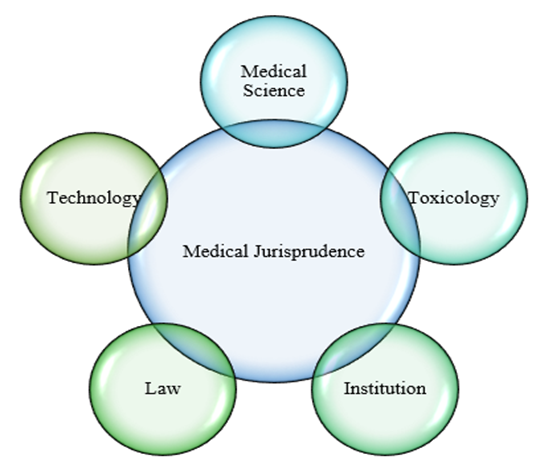 | Figure 1. Integrated Medical Jurisprudence |
1.2. Forensic Medicine
- Forensic Medicine is a branch of medicine, which deals with the application of principles of medical knowledge for the purpose of law for furtherance of justice. It is medical aspect of law. Forensic medicine is medicine as applied to the problems of the law. Different terms considered synonymous, such as: (a) State medicine, (b) Court Medicine, (c) Legal Medicine, (d) Forensic medicine, and (e) Medical Jurisprudence.It plays an important and at times, indispensable part in the investigation of crimes against the person, in the prosecution of offenders in this field of crime, and in the solution of the legal problems arising in the investigation of untoward deaths [4].
1.3. Functions of Medical Jurisprudence
- Medical jurisprudence is a vital aspect to practice of physicians in the State. Its functions are crucial for medical doctors with legal support, which deals with forensic science, legal medicine and moral principles [5]. Because, moral principles are the key instruments for registered medical practitioners in their dealings with (i) doctor to doctors, (ii) their patients, and (iii) the state. Medical Expertise is crucial in deaths investigation due to role of Medical Science in the Administration of Criminal Justice.
1.4. Law and Medicine Relationship
- The relation relates to Legal Permission for Medical Doctor’s towards Patients-Doctors-State including the following parameters, which as shown in Figure 2. For effective relationship between law and medicine, two factors followed earlier to connect the birth and death, such as: (i) Ancient and learned societies => Since antiquity for legal medicine, and (ii) Common goals / interest: Know the truth for service to mankind.
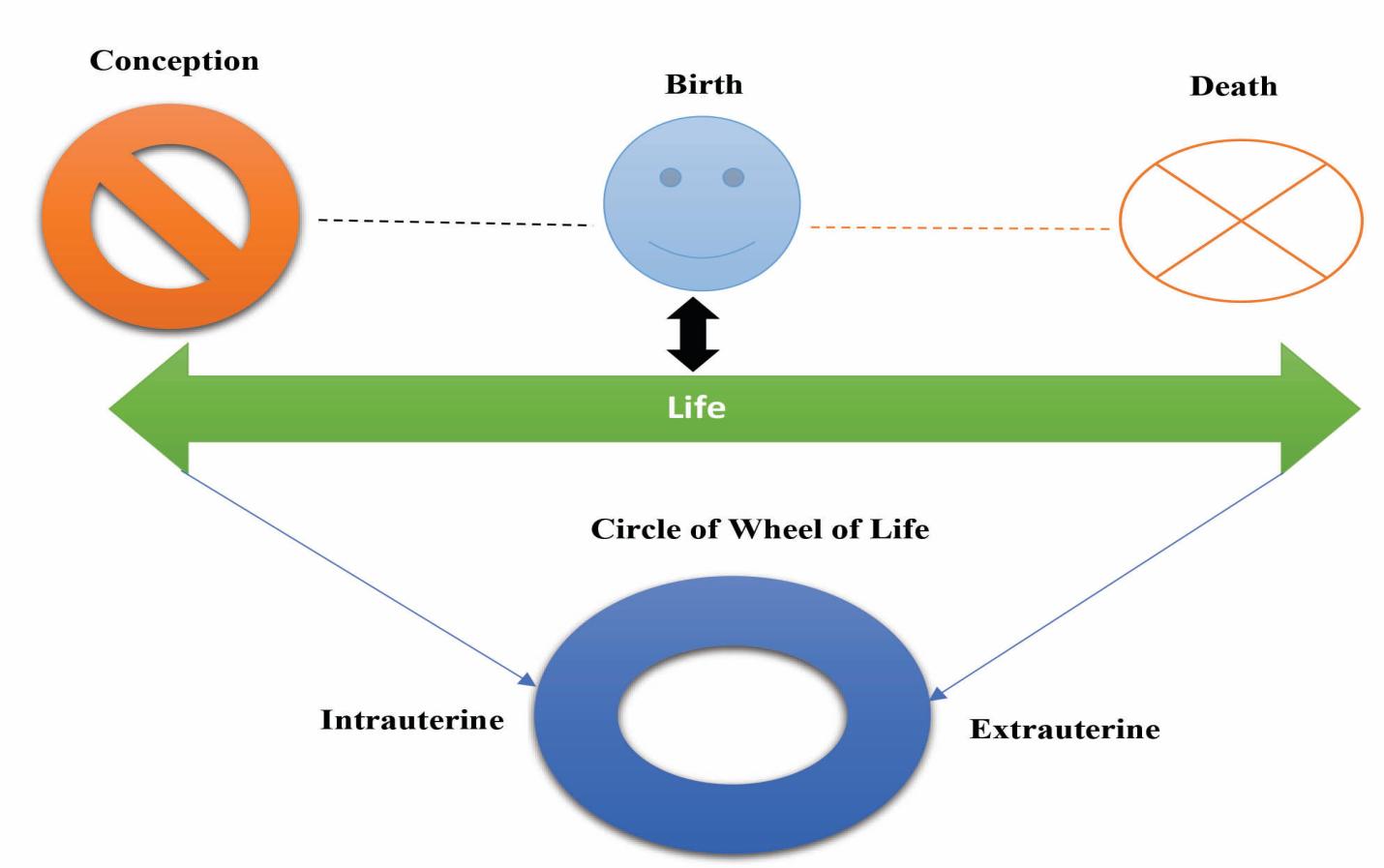 | Figure 2. Circle of wheel of life |
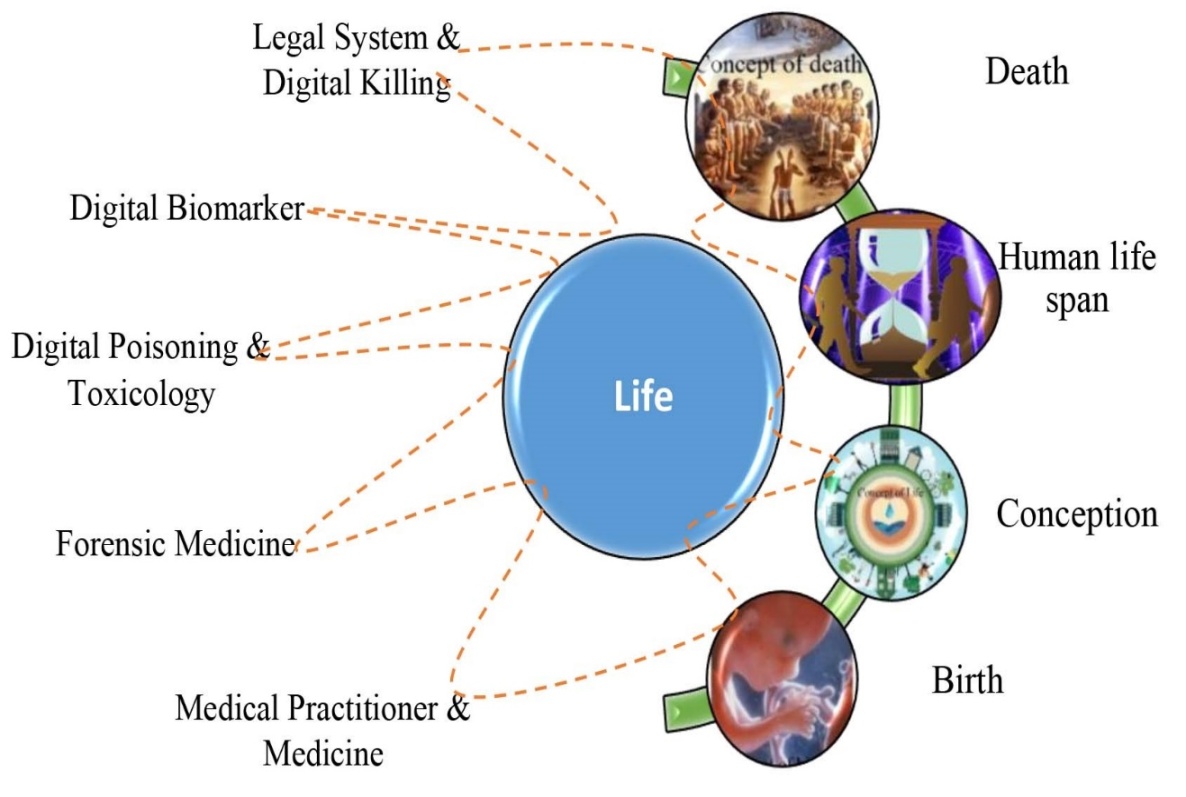 | Figure 3. Digital Life connects with birth, conception, lifespan and death |
1.5. Criminal Justice in Medical Science
- Authority shifted to the society for crime investigation under specific laws and agencies, trial and punishment including: (1). Substantive law, (2). Legal procedure, (3). Execution of justice, (4). Advanced Health technology. Cognizance of responsibility factors is connected with criminal justice and Medical Investigation.
1.6. Law and Medicine Bondage
- Law and medicine bondage is the reciprocal relationship to settle medical jurisprudence, which as shown in Figure 4.
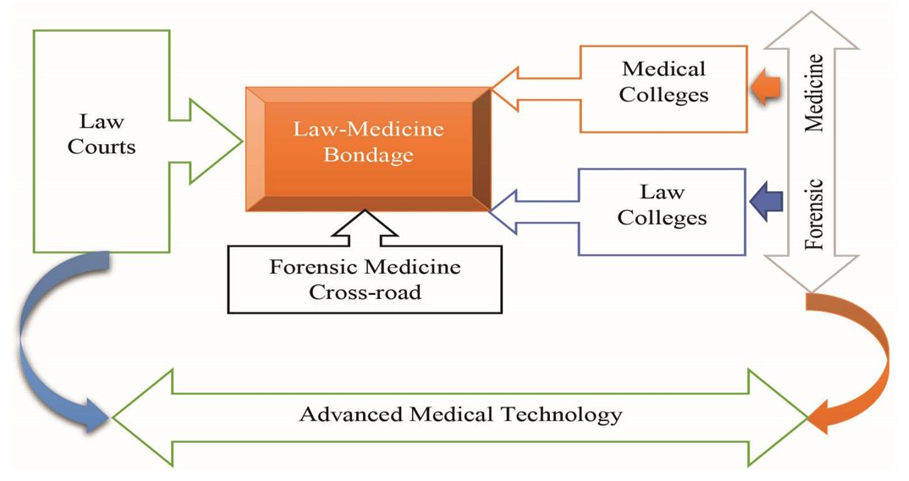 | Figure 4. Law and Medicine bondage |
1.7. Legal Aspect
- Independent Phase: Independents are responsible for dependents as well as for independents. This is the concept of responsibility and understanding of law. Life is the presence plus integration of vital systems of body. Purpose of life: Is to exist (integrity of life)? Purpose of body: Is to function? Law is interested in both i.e., integrity of life and function of body, which as shown in Figure 5. Anybody doing any harm to these two purposes should be made punishable.
 | Figure 5. Legal aspect in life |
2. Materials and Methods
2.1. Data and Sample Size
- Materials and Methods followed in the following URLs [1-12] for data collection:URL: http://article.sapub.org/10.5923.j.bioinformatics.20211101.01.html [1]URL: http://article.sapub.org/10.5923.j.ajbe.20201001.03.html [2]URL: http://article.sapub.org/10.5923.j.fs.20211101.01.html [3]URL: https://ojs.bilpublishing.com/index.php/jer/article/view/2826/2632 [4]URL: http://article.sapub.org/10.5923.j.diabetes.20200902.02.html [5]URL: http://article.sapub.org/10.5923.j.ijvmb.20211001.03.html [6]URL: http://article.sapub.org/10.5923.j.scit.20211101.02.html [7]URL: http://article.sapub.org/10.5923.j.geo.20211101.02.html [8]URL: http://article.sapub.org/10.5923.j.ijas.20211102.02.html [9]URL: http://article.sapub.org/10.5923.j.env.20211102.01.html [10]URL: https://ccsenet.org/journal/index.php/gjhs/article/view/0/46717 [11] URL: http://article.sapub.org/10.5923.j.ijim.20221101.01.html [12]Qualitative and quantitative health data were collected through:ο a. field survey, observation, interviews, informal contact on the innovative technological users towards doctors, patients and administrations with diverse services.ο b. Secondary data were obtained from different sources.2. Tracking Processes at a fixed GPS position and open active eyesο i. One to one tracking with node sensorsο ii. One to many tracking with central sensorsο iii. Many to many with distributed sensors
2.2. ISNAH Procedure
- ISNAH- Impact of Sensor Networks towards Animals and Human beings. The study followed different steps, which as shown in Figure 6.
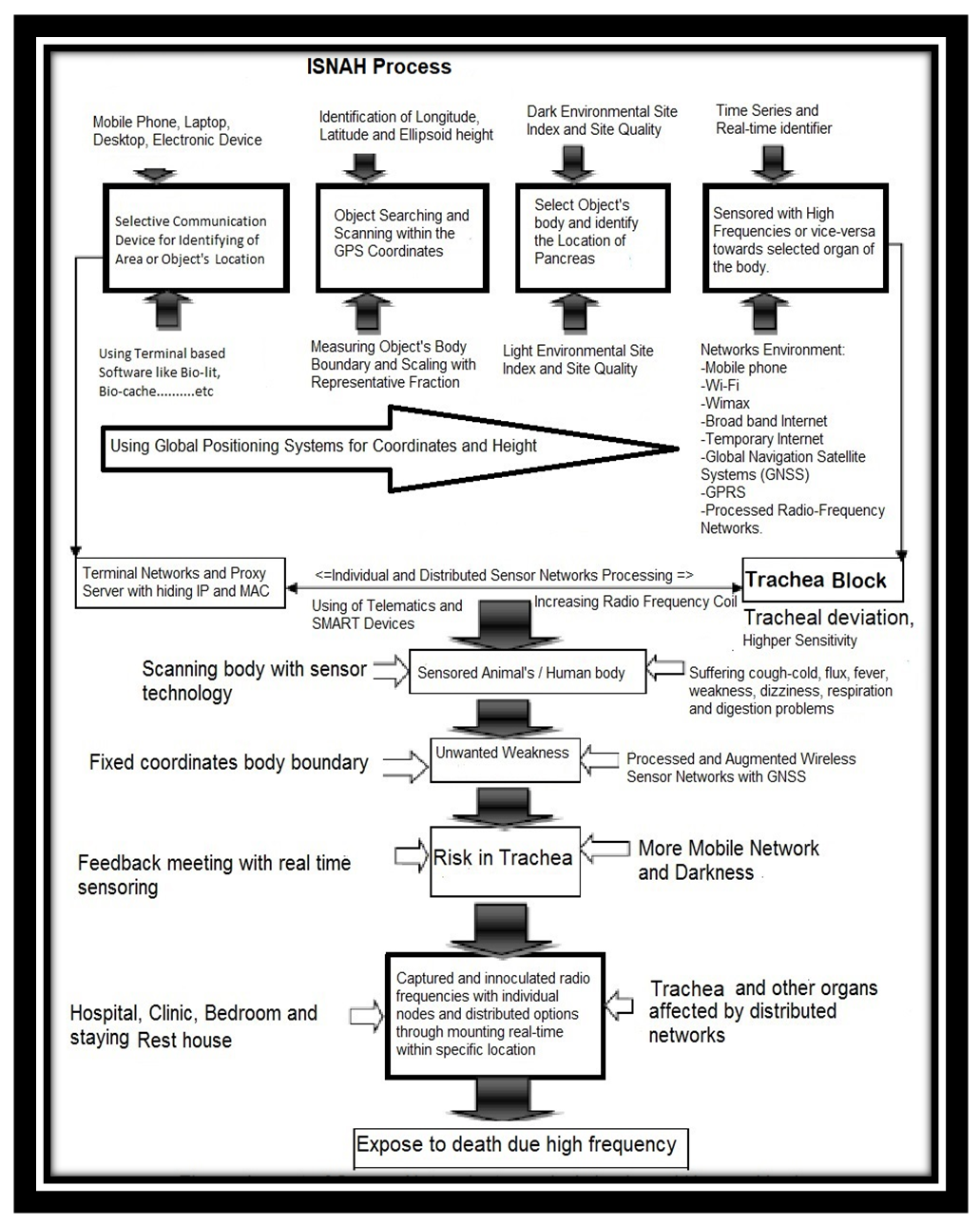 | Figure 6. Procedure of ISNAH towards doctors and patients [1] |
2.3. Policy Scoring
- Legislation scoring was calculated for development of updated law, policy, order and related schedule for health management system effectively with the certain period in Bangladesh.
 | (1) |
2.4. Data Compilation
- All quantitative and qualitative related medical data were collected and compiled according to research objectives.
2.5. Data Analysis and Interpretation
- The compiled data checked for accuracy from various sources are also verified for the preparation of master sheet for analysis and interpretation using updated software like MS Office 2019, R ver. 3.6 and SPSS ver.29.
3. Results
- The study assessed the existing legal medicine on the stated guidelines of Bangladesh Medical and Dental Council (BM&DC), which as illustrated as below:
3.1. Guidelines of Bangladesh Medical & Dental Council
- ü Recognition of medical qualification.ü Supervision of undergraduate medical educationü Supervision of post graduate medical educationü Recognition of foreign medical educationü Derecognitionü Medical registerü Warning noticeü Appeal against disciplinary action ü Professional death sentence
3.2. Duties of Medical Practitioners Towards Patient
- The study showed the following duties of Medical Practitioners towards patients.(i) Treatment of patient is implied contract, (ii) Duty to sick, (iii) Duty to continue treatment, (iv) Duty to earn confidence, (v) Duty to children and infirm, (vi) Charge for professional service, (vii) Right to choose a patient, (viii) Duty to give proper directions, (ix) Duty to offer proper regime of treatment, (x) Duty to notify communicable diseases, (xi) Examination and consent, (xii) Duty as regards result of examination, (xiii) Professional secrecy, (xiv) Privileged communication
3.3. Privileged Communication
- Bonafide statement of a registered medical person on a subject matter of public interest to the concerned authority to protect the interest of the community.Conditions of privileged communicationv Infectious diseasesv Venereal diseasesv Employers & employeesv Notifiable diseasesv Suspected crimev Patient’s own interest: Pregnancy- radiation free zonev In courts of law
3.4. Duties of Medical Practitioners towards State
- × Notification of infectious diseases× Notice to police× Notification of births and deaths× Issuing of certificates× Respond to emergency State servicesOverall, the medical doctor examines the role of the state and civil society in health promotion and disease prevention within the country.
3.5. Duties of Medical Practitioners towards one another
- ü Extend same honour, respect & good behavior as expected from them.ü Should not do or utter anything to lower down the name of colleagues.ü Should not entice patients away from colleagues.ü Free medical service to fellow colleagues.
3.6. Professional Misconduct
- ο Conduct considered as disgraceful or dishonorable by professional breathern of good repute and competency.ο Issue of false medical certificatesο Covering up unqualified personsο Helping quacksο Canvassingο To personally open chemist shopο To prescribe habit forming drugsο Disclosing professional secrets of patientsο Failure to notifyο Treating patients under the influence of drink or drugsο Fee splitting/dichotomy
3.7. Professional Negligence
- ο Negligence - doing something that one is not supposed to do, or failing to do something that he is supposed to do.ο Professional negligence - absence of reasonable care and skill, or wilful negligence of a medical practitioner in the treatment of patient which causes bodily injury or death of patient.
3.8. Civil Negligence
- Following conditions should be satisfied for proving liability of negligence-ο Duty-existence of duty of care by the doctor.ο Dereliction-failure on the part of doctor to maintain applicable standard of care and skill.ο Direct causation- any damage was caused by breach of duty.ο Damage – lost wages, medical expenses and mental duress.
3.9. Crimes Against the Person
- Crimes against the person included (1). Bodily harm, (2) Rape, (3). Abortion, (4). Infanticide: baby homicide, and (5). Homicide, (6). CASSID (Common Acute Sensor Sudden Infection and Disorders), (7). Sensor Diseases
3.10. Some Investigation Problems
- i. Identificationii. False interface in forensic pathologyiii. Unexplained deathsiv. Apparent sensor drowning and fell-down.v. Wireless Sensor Trackingvi. Digital Poisoning, andvii. Digital Killing
3.11. Tracking towards Doctor/Patients
- ο Doctors track to doctorsο Doctors track to patientsο Patients track to doctorsο Cyber hackers track to AllMedical Cyber criminals abuse the advanced wireless sensor devices for killing medical professionals and others due to active open eyes, fixed GPS location and insecure sensor places, which as shown in Figure 7.
 | Figure 7. Sensor Pandemic Disease Tracking Systems towards physicians and relevant stakeholders [11] |
3.12. Perception
- The study represents the health-related rules and regulations amended as the highest in Bangladesh within the period of 2010 to 2020, while policy scoring is above 90% of health services. The growth of health service centres maximized within the same period but relevant laws need to be improved with political commitments due to expansion of innovative technology towards the recovery from pandemic diseases.
3.13. Legal Medical Knowledge
- Medical jurisprudence knowledge is essential for health services with innovative technology in Bangladesh, but such medication legal knowledge is below par. The study assessed the existing medical jurisprudence is inadequate for dynamic public health security in Bangladesh, which as represented in Figure 8.
 | Figure 8. Advancing system of medical jurisprudence [13] |
3.14. Volving Medical Jurisprudence
- The study revealed that medical jurisprudence behooves all of us to keep in mind that while technology is evolving and enhancing medical practice, so may evolution of medico-legal principles of jurisprudence match on to deal with adverse clinical results. Not Pari passu or anywhere near that. In fact, one of the points of this paper exhorts is further medico-legal evolution embracing scientific product/technology involvement in alleged malpractice. As bio-engineering churns out new and complex equipment involving multiple scientific principles, full understanding of the operation, malfunction, de-and re-assembly responsibilities may involve new and complex legal challenges.
3.15. Digital Forensic Medicine and Clouding System
- There is a cloud networking relationship to be sick person in a moment due to misuse of advanced technology, which as shown in Figure 9, including (a) Computer GPS Location, (b) Wireless Sensor Network, (c) Mobile Networks+ Sensor Networks, (d) Digital Sensor Networks, (e) Built-in Telematics device, (f) Wireless Clouding System, (g) Digital Treatment.
 | Figure 9. Clouding system towards medical practitioners [4] |
3.16. Medical Etiquette
- The study revealed that medical etiquette depends on cconventional laws, customs of courtesy, code of conduct for doctor with his colleagues and National Health Policy linking with Sustainable Goals 2030. The study illustrated on integrated medical jurisprudence or legal medicine in different years amended, which as shown in Figure 10.
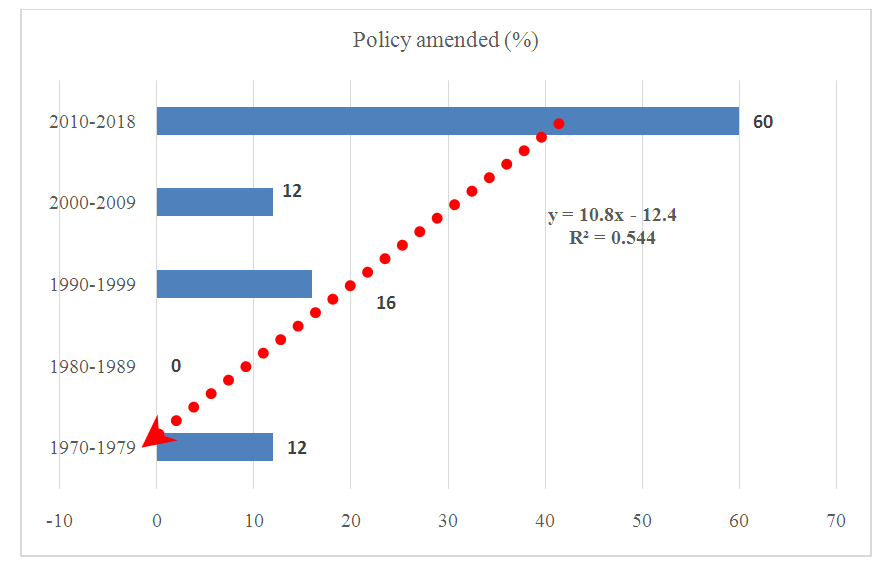 | Figure 10. Health Policy amended in Bangladesh |
4. Discussion
4.1. In-body GPS Sensor
- In-body GRPS sensor creates 380 CASSID (Common Acute Sensor Sudden Infection and Disorders) among doctors, patients, health professionals and others including (Figure 11) including coronavirus disease, ARDS, Cardiac Arrest, Tracheal Cancer, Breast Cancer, Multiple Myeloma, Alzheimer Related Dementia Disorder and Diabetes.
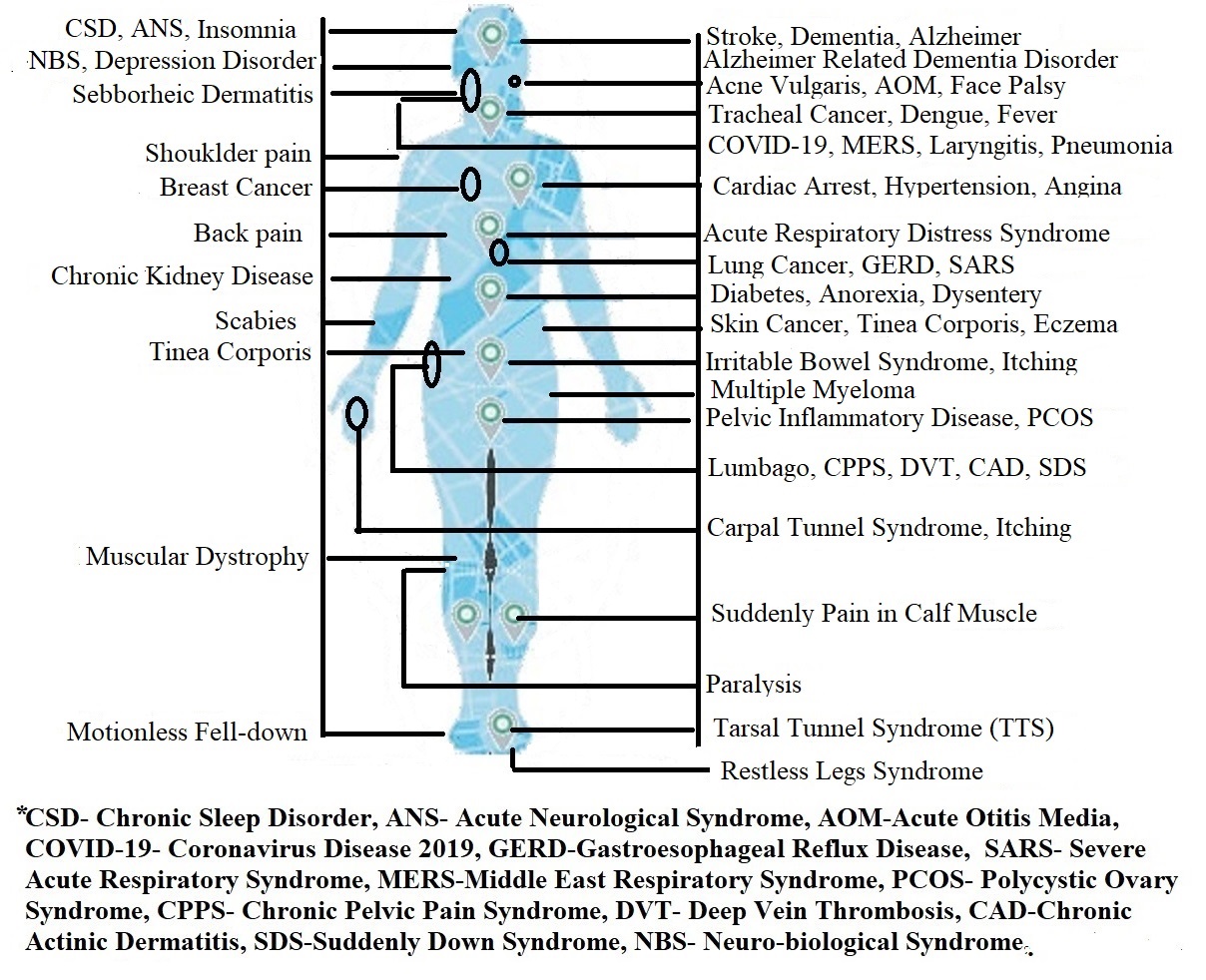 | Figure 11. Sensor diseases affect in health professionals [9] |
4.2. Advanced Sensor Technology and COVID-19
- Life in general, medicine and surgery, is somewhat replication the mad rush of daily life – destination, at times, unknown. A mentality is commoner than one supposes and is more than likely to lead to unpleasant legal encounters. Advanced technology is being used, especially new technology, however routine it becomes, it is no longer the doctor’s prerogative to shield or protect or for any reason keep back from the patient, all available information pertinent to case at hand with different tracking steps, which as shown in Figure 12.
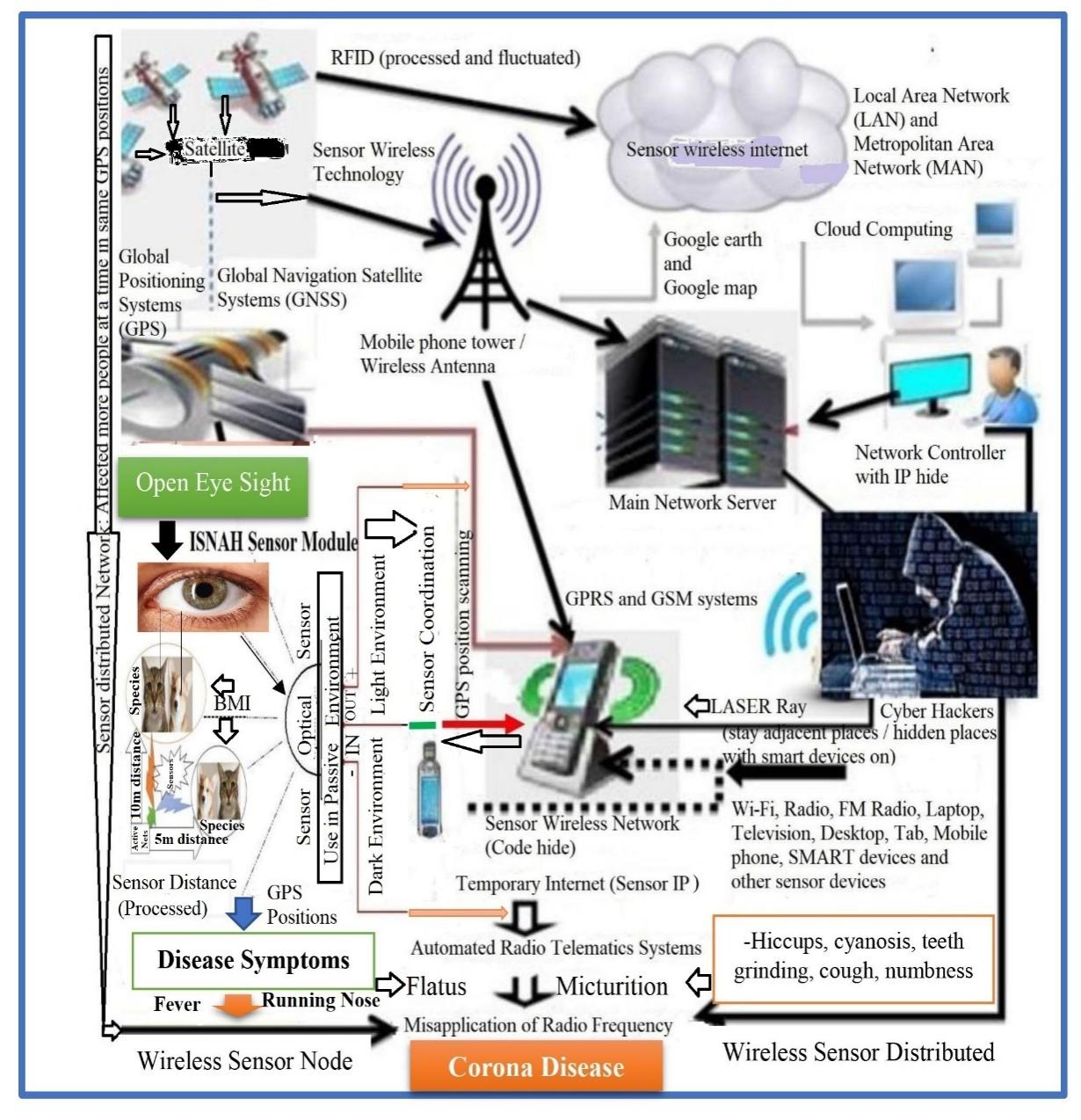 | Figure 12. Pandemic disease attacks towards doctors, patients and others [5] |
4.3. Medicine and Technology for Recovery
- Determining the age of a wound is challenging in forensic pathology. But it can contribute to the reconstruction of crime scenes and lead to the arrest of a suspect. Forensic pathologists must identify the timing and order of injuries in cases involving multiple traumas by different offenders, because Punishment typically varies according to the severity of the injury. In cases of violent death, the main focus is on: (i) whether an injury was caused while the individual was alive or during the agonal or postmortem period, (ii) how long the victim survived after the wound was inflicted [14].Treatment systems includes following systems which as shown in Figure 13.ο Treatment with Medicineο Treatment with Technologyο Treatment with Psychologyο Treatment with Others
 | Figure 13. Recovery system from pandemic disease [1] |
4.4. Novelty
- ο Quick sensor network affected towards doctors and patients.ο Disseminate the distributed sensor network to the whole hospital through individual or group wise.ο Excess weighted doctors/patients are more prone to be negatively affected by sensor telematics network because of peripheral congested environment and splitting high frequency.ο The radio frequencies of telematics (500 to 999 mHz) were detected using Automated Radio Telemetry System within the eye-sight distances. ο Exposure high RFID detects to die due to CASSID (Common Acute Sensor Sudden Infections and Disorders).
4.5. Potentiality
- ο It can enhance security systems for physicians, health professionals, scientists, researchers and other stakeholders.ο Experts have tried to implement ways of reducing this impact by encouraging pertinent institution to go competitive market with advanced technology through alternative potentiality.ο Large potential on medical technology uses including learning, research, servicing and access benefit sharing to achieve specific goals related to national health policy in connection with Sustainable Development Goals 2030.
4.6. Bio-sensor Facilitated Medical Crime
- ο Doctors and Senior Professional’s death from COVID-19:ο Doctors’ death: 187 (BMA, 2021)ο Banker: 133, (Prothom Alo, 2021) and ο Police and Administration: 97 (Prothom Alo, 2021)ο Global Health Professional deaths: 1 lakh 80 thousand (WHO, 2021)
4.7. Medical Autopsy
- ο Report received through court with Procrastination.ο Legal report is in risk due to misusing of voice coding.ο Medical expert provides the biased report through tracking with bio-hypnotism.
4.8. Privacy and Security
- Privacy, Medical Confidentiality and Data Protection are in risks due to insecure wireless sensor networks worldwide.
4.9. Conceptual Framework
4.10. Challenges
- The study identified that every medical professional is in risk due to advanced wireless sensor technology due to following parameters but no medical jurisprudence [1-15], which as shown in Figure15.ο In-body GPS Sensorο Digital Body Burningο Potential Legal Issues for Medical Professionalsο Digital Killing: i. Track at trachea, Lung, heart and the entire body.ο False interface display during identification of disease markers due to abuse of advanced wireless sensor technology.
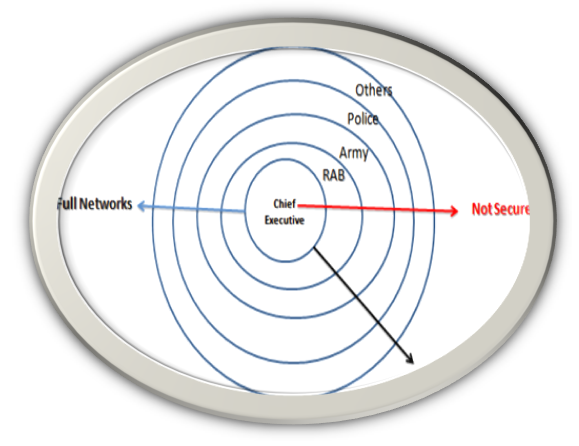 | Figure 15. Doctors and others are in risks due to insecure wireless sensor networks [1] |
4.11. Inadequate of Existing Medical Jurisprudence
- ο No available section regarding wireless sensor security to recover from COVID-19 [7]; [22], diabetes [4], ARDS [19], heatwaves [18], cardiac arrest [12], Acute Lymphoblastic Leukaemia [20], and numbness [6].ο Existing Jurisprudence is obsolete due to advances in sensor technology [17].ο The national Medical Jurisprudence is not secure for medical practitioners, health professionals, patients and other stakeholders [14]; [15]; [16]; [21]; [23].
4.12. Future Research Trajectory
- As new technologies continue to emerge, doctor/patient’s roles will continue to evolve, with each advance, bringing a safer and healthier future for both physicians, patients and the state with secure sensor technology. As medical doctor, health professionals, researchers, scientists, engineers and network specialists continue to make leaps forward with these innovations, more lives will be saved and more research will receive assistance [11-13].
5. Conclusions
- The study documented the root causes that reflect the health service priorities with policy integration, implementation and improvement to foster national health management objectives for safeguarding the sustainability of public health systems. For this, the research proposed dynamic medical jurisprudence in connection with advanced technology towards medical practitioners.
6. Recommendations
- ο There can be temporary drawbacks when advanced technology is first implemented, but these are outweighed by the long-term benefits of the technology. ο It’s of vital importance that physicians are given the necessary education to use new technologies that are being introduced in their workplaces.ο Should share the applications of emerging technologies towards relevant research practices as a regular basis., particularly wireless sensor Technology (WST).ο Should improve medical jurisprudence in connection with national health policy and Sustainable Development Goals (SDGs) 2030.
Declaration
- FundingThis research work is a part of PhD Thesis, which was funded by the Zamalah Postgraduate Scholarship of UNIMAS, Malaysia and also sponsored by the Information and Communication Technology Division, Ministry of Posts, Telecommunications and Information Technology, Government of People’s Republic of Bangladesh. The funders had no role in the design of the research, in data collection, analyses or final interpretation of data, in the writings of the manuscript, or in the decision to publish the findings.Data AvailabilityThe data being used to support the findings of this research work are available from the corresponding author upon request. Competing InterestsThe authors declare no potential conflict of interests in this research work.
ACKNOWLEDGEMENTS
- The authors acknowledged the authority of Universiti of Malaysia Sarawak (UNIMAS), Malaysia for providing the Zamalah Postgraduate Scholarship for the completion of PhD degree. The authors are also grateful to the authority of the Information and Communication Technology Division, Ministry of Posts, Telecommunications and Information Technology, Government of People’s Republic of Bangladesh, for PhD Fellowship during the higher study in Malaysia. The authors acknowledged the authority of North East Medical College & Hospital (NEMCH), affiliated with Sylhet Medical University at Sylhet in Bangladesh for kind support. The authors also acknowledged the higher authority of International Conference on Innovation and Transformation for Development (ITD-2021) at Green University of Bangladesh, Dhaka, Bangladesh for oral presentation.
 Abstract
Abstract Reference
Reference Full-Text PDF
Full-Text PDF Full-text HTML
Full-text HTML